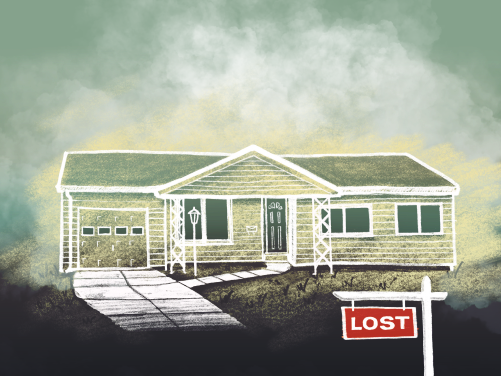
In May 2008, the United States was already months into the Great Recession, although most Americans weren’t yet feeling the pain.
Thousands of homeowners were defaulting on subprime mortgages they couldn’t afford — or even understand — and some of the nation’s largest financial instutions were wobbling like towers built of Jenga blocks.
The national awakening came in September 2008, as Americans watched grim-faced government and political leaders scramble to shore up big-name banks with taxpayer-funded bailouts. In the St. Louis region, thousands of residents were facing foreclosure, and Chrysler was closing its Fenton-based minivan plant and laying off thousands of autoworkers.
When Clayton-based manufacturer Barry-Wehmiller lost 40 percent of its product orders in early 2009, CEO Bob Chapman stuck with its people-first business model and ordered company-wide furloughs to prevent layoffs.
Many Millennials were already deeply in debt when they graduated college and entered a dismal U.S. labor market that had hemorrhaged 8 million jobs during the recession. Today, they are still seeking financial security.
Economy has recovered, but St. Louis woman's American Dream is still gone

Maureen McKenzie’s American Dream was a small one. Just 900 square feet on a tree-shaded cul-de-sac. Her home joined hundreds of thousands snatched by the foreclosure crisis. "We're still struggling" 10 years later, she says.
The Great Recession wrought life-altering changes for St. Louis-area autoworkers
Thousands of autoworkers across the St. Louis region lost their jobs as the Great Recession hit Chrysler and other manufacturers. Some have regained a foothold, but they make less than they once did.
Granite City steelworkers in the spotlight as they prepare to make steel again

U.S. Steel laid off about 2,000 workers in Granite City in 2008 and halted all steel production in 2015. Now, the Metro East steelworkers find themselves back to work, but in the midst of an international brouhaha over steel tariffs.
How a Clayton manufacturer shared sacrifice to avoid layoffs during the Great Recession

When 40 percent of Barry-Wehmiller's product orders evaporated in early 2009, CEO Bob Chapman doubled down on the manufacturer's people-first business model and mandated company-wide furloughs to save laying off a single employee.
10 years after the Great Recession, millennials still struggle to catch up with the economy
Many Millennials were already deeply in debt when they graduated college and entered a dismal U.S. labor market that had hemorrhaged 8 million jobs during the recession. Today, they are still seeking financial security.
Nation rallied around veterans after Great Recession, but many are underemployed

Ten years after the Great Recession, the unemployment rate for the nation’s veterans is lower than ever, but some analysts estimate that about one-third of veterans are underemployed for their skill levels.
Granite City is making steel again, but many are still struggling this holiday season
Plans to put 1,500 people back to work at Granite City's steel plant has been a relief to many, but the economic boost from the plant’s reopening has yet to trickle down to many in the city who are struggling financially.
Experts would later pinpoint the start of the Great Recession to December 2007 and its end to June 2009. But the pain for consumers began earlier and would drag on far longer. It was the most significant downturn since the Great Depression, and it would spread globally.
In the United States, employers shed more than 8 million jobs, and 4 million Americans lost their homes to foreclosure. The Great Recession directly disrupted the lives of millions of Americans and altered the future for countless millions more.
A government-sponsored commission would blame exotic mortgages, Wall Street and the failure of regulators for the financial crisis, but members would disagree over whether it had been “avoidable.”
Here is a timeline of some of the key events.
Single-family residential mortgage delinquency rate
Data retrieved from FRED, Federal Reserve Bank of St. Louis
2007
January 25: RealtyTrac, an online foreclosure marketer, reports a noticeable upswing in U.S. foreclosures: 1.2 million filings in 2006, affecting one of every 92 U.S. households. That was a 42-percent increase over 2005. The company pointed to slowed housing sales and ballooning monthly mortgage payments for homeowners who held “riskier” types of adjustable-rate and subprime mortgages.
February 27: Freddie Mac, the Federal Home Loan Mortgage Corporation, says it will no longer buy risky subprime mortgages and mortgage-backed securities. Read more: What are mortgage-backed securities?
August 9: BNP Paribas, the largest listed bank in France, freezes funds worth billions of dollars and cites problems in the U.S. subprime mortgage sector. Read more
October 10: A coalition of nonprofits and the lending industry form the Hope Now initiative to assist struggling U.S. homeowners. The U.S. Department of the Treasury and the Department of Housing and Urban Development (HUD) encourage the initiative. Read more
December: The Great Recession begins, although no one knows it yet. (The date would later be determined by the National Bureau of Economic Research, which has been studying business cycles since 1929.) Read more
2008
January 11: Bank of America announces that it will purchase struggling Countrywide Financial in a deal worth about $4 billion.
January 30: U.S. foreclosures increase by 75 percent in 2007, according to RealtyTrac’s annual report. Read more
February 13: President George W. Bush signs the Economic Stimulus Act of 2008 that includes tax rebates to low- and middle-income taxpayers, tax incentives to stimulate business investment, and an increase in the limits imposed on mortgages eligible for purchase by government-sponsored entities (GSEs) Freddie Mac, Fannie Mae and the Federal National Mortgage Association. (GSEs are government-sponsored enterprises that purchase and securitize mortgages from lenders who then use the proceeds to finance more mortgages.)
March 16: Bear Stearns, a global investment bank and brokerage firm, fails and is sold to JPMorgan Chase for $2 per share. The Federal Reserve provides a bridge loan of $12.9 billion to prevent Bear Stearns from collapsing before the sale. Read more
June 30, 2008: Chrysler announces that it will shut down its Fenton-based south St. Louis Assembly plant, which builds minivans, and cut a production shift on its Dodge Ram at Chrysler’s north St. Louis Assembly plant. (The minivan plant would shutter in October 2008.)
The Chrysler closure accounted for a hefty share of regional pain: nearly one-third of the region’s job losses from 2007 to 2010, according to a study commissioned by St. Louis County, the state of Missouri and the city of Fenton. The final tally: 43,000 jobs, when factoring in the impact the layoffs had on suppliers and businesses that catered to its workers. Read more: How the Great Recession wrought life-altering changes for St. Louis area autoworkers
July 15: In St. Louis, KETC-Channel 9 hosts a live call-in show about foreclosure as part of an outreach effort called Facing the Mortgage Crisis.
Maureen McKenzie is among the guests who, standing before the live audience, identifies herself as a foreclosure victim to a panel of experts discussing the mortgage crisis. She lost her American Dream — a 900-square-foot ranch house on a tree-shaded cul-de-sac. Today, McKenzie says it was difficult to go public with her case, but she felt the need to speak out about what was happening. Read more: Economy has recovered, but St. Louis woman's American Dream is still gone
July 30: President Bush signs the Housing and Economic Recovery Act of 2008, creating the Hope for Homeowners program. The $300-billion Federal Housing Administration (FHA) program is intended to refinance subprime mortgages into 30-year fixed-rate mortgages when lenders were willing to write down principal loan balances to 90 percent of current appraisal value.
September 6: The new Federal Housing Finance Agency places GSEs Fannie Mae and Freddie Mac in government conservatorship. The U.S. Treasury provides $189.5 billion to shore them up.
September 15: Bank of America announces that it will buy Merrill Lynch & Co. for $50 billion. Lehman Brothers files for Chapter 11 bankruptcy protection. The stock market plunges.
September 16: The Federal Reserve authorizes an $85-billion loan to insurance giant AIG, the American International Group, in exchange for about 80 percent of its stock. The bailout fuels growing criticism of government intervention to shore up private financial institutions deemed "too big to fail."
September 24: President Bush addresses the nation about the economic crisis and urges Congress to pass his administration’s $700-billion troubled-asset proposal. Read more
September 29: The Dow Jones industrial average plummets after the U.S. House of Representatives votes down the $700-billion bailout legislation. The 778-point fall sets a one-day record.
October 3: Congress approves a revised Emergency Economic Stabilization Act, establishing the $700-billion Troubled Asset Relief Program (TARP); President Bush immediately signs it into law. Read more
Nov. 4: Democrat Barack Obama defeats Republican John McCain in the presidential election.
November 12: In a surprising move, Treasury Secretary Henry Paulson announces that TARP funds will not be used to purchase bad mortgages, after all, but will instead focus on buying stock in troubled financial institutions.
November 18: Executives of Ford, General Motors and Chrysler ask Congress for $25 billion in federal loans for the auto industry.
November 20: Fannie Mae and Freddie Mac announce a moratorium on foreclosures on mortgages between Nov. 26 and Jan. 9, 2009, while they launch a new modification program.
November 25: The Fed rolls out a plan to purchase direct obligations of Fannie Mae, Freddie Mac and Federal Home Loan Banks and mortgage-backed securities backed by the GSEs.
December: U.S. Steel idles its century-old Granite City plant for the first time in its history and lays off about 2,000 workers. The plant would reopen in mid-2009, but halt steel production again in 2015. Now, the Metro East steelworkers find themselves back to work, but in the midst of an international brouhaha over steel tariffs. Read more: Granite City workers in the spotlight as they prepare to make steel again
December 8: Three weeks after InBev acquires Anheuser-Busch, the corporation announces that it will cut 1,400 jobs — about 1,000 of them in St. Louis. Read more
December 19: The Treasury Department authorizes TARP loans of up to $13.4 billion for General Motors and $4 billion for Chrysler.
December 23: The National Association of Realtors releases grim numbers: Sales of existing homes in November fell 8.6 percent, with new-home sales falling 2.9 percent. The median existing home price fell by 13.2 percent, probably the largest decline since the Great Depression. Read more: Beacon-omics 101: Foreclosures remain at the heart of the economic crisis
2009
January 15: RealtyTrac reports that foreclosures rose by 81 percent in 2008, a record-setting 3.2 million filings on 2.3 million properties. One in every 54 U.S. homes had received a foreclosure notice of some type.
January 20: President Barack Obama takes office.
February 17: President Obama signs into law the American Recovery and Reinvestment Act of 2009, which includes spending measures and tax cuts intended to stimulate economic recovery.
February 18: The Home Affordable Modification Program (HAMP) is established to help at-risk homeowners modify their mortgages. The Home Affordable Refinance Program (HARP) is tasked with helping borrowers refinance mortgages owned or guaranteed by Fannie Mae or Freddie Mac. The FDIC announces that there were 25 bank failures and five assistance transactions in 2008.
March 3: The U.S. Treasury and the Federal Reserve launch the Term Asset-Backed Securities Loan Facility (TALF) to lend up to $200 billion to eligible owners of AAA-rated asset-backed securities backed by auto loans, credit card loans, student loans and small-business loans. Read more
May 6: Chrysler announces it will close its Fenton-based north St. Louis Assembly plant, which built Ram trucks. Read more
June: The Great Recession ends, although economists won’t know this until later. It was the longest recession in the U.S. since the Great Depression.
June 30: The U.S. Treasury proposes a new Consumer Financial Protection Bureau. The bill would transfer current consumer-protection functions of the Federal Reserve, Comptroller of the Currency, Office of Thrift Supervision, FDIC, FTC and the National Credit Union Administration to the new agency.
October 14: The Dow Jones industrial average closes above 10,000 for the first time since Oct. 3, 2008.
November 9: After Pfizer’s acquisition of Wyeth, the pharmaceutical company announces that it will cut 600 jobs in St. Louis. Read more
2010
July 21: President Barack Obama signs the Dodd-Frank Wall Street Reform and Consumer Protection Act, Public Law 111-203 into law. The law is aimed at promoting financial stability in the United States through a variety of mechanisms. Read more
October 13: The attorneys general of all 50 states band together to announce an investigation of mortgage-loan servicers accused of robosigning documents. Bank of America, the largest U.S. mortgage servicer, temporarily halts foreclosure evictions. JPMorgan Chase and others halt foreclosures pending reviews.
2011
Jan. 27: The Financial Crisis Inquiry Commission releases its final report on the causes of the financial and economic crisis in the United States. Members of the commission blame exotic mortgages, Wall Street and the failure of regulators but disagree over whether the crisis was avoidable. Read more
April 13: The Office of the Comptroller of the Currency and the Federal Reserve System announce they are taking action against mortgage servicers and third-party vendors for unsafe and unsound practices. Read more
August 2011: The iconic Chrysler water tower in Fenton comes down.
November 1: The Federal Reserve and the Office of the Comptroller of the Currency announce that borrowers who believe they were financially harmed during the mortgage foreclosure process 2009 and 2010 can request an independent review and potentially receive compensation. Read more
2012
Jan. 12: RealtyTrac announces that the nation’s foreclosure activity has slowed for the first time in four years. However, the report notes that filings were delayed because of documentation and legal issues and predicts they would begin rising in 2012.
February 9: State attorneys general and the federal government announce details of a $25-billion settlement with the nation’s five largest mortgage servicers: Bank of America Corporation, JPMorgan Chase & Co., Wells Fargo & Company, Citigroup Inc. and Ally Financial Inc. (formerly GMAC). Read more
June 21: The Office of the Comptroller of the Currency and the Federal Reserve announce a framework for compensating victims of foreclosure abuses during 2009 and 2010 under the Independent Foreclosure Review process. Homeowners who wrongfully lost their homes could receive $125,000 or more; smaller awards are set for a range of other violations, including modifications that were improperly denied. Read more
Sources: past St. Louis Beacon and St. Louis Public Radio stories; media coverage, the Federal Reserve and other government agencies, Realtytrac.
Art by David Kovaluk • Timeline compiled by Mary Delach Leonard and Brian Heffernan • Editing by David Cazares • Production by Brent Jones
